
views
- Research your family history by talking with relatives or using an online database and determine who you’re including in your family tree.
- Sketch the outline of your tree lightly with pencil, starting from the base and working up and out toward the branches.
- Place your family members’ names on the branches, writing the older generations near the bottom and the younger ones at the top.
Researching Your Family History

Ask relatives and use the internet to research your family. Before you even start designing your tree, you need to know who’s going to be on it. Talk to your parents, grandparents, aunts, uncles, and cousins to gather as much information as possible about your relatives and their relation to you. Go and search through genealogy databases like Familysearch.org to further explore your ancestry. Ask your family members questions about their siblings, children, parents, and any ancestors they may know about. Ask for names, birthdates, death dates, and anything else you’re curious about. Be sure to talk to multiple family members to compare facts and make sure everyone’s stories line up. If some stories don’t line up exactly, ask more detailed questions or talk to more family members. If you want your tree to be super detailed, gather things like family members’ birth dates, death dates, where each family member comes from, pictures, and anything else you want to include.
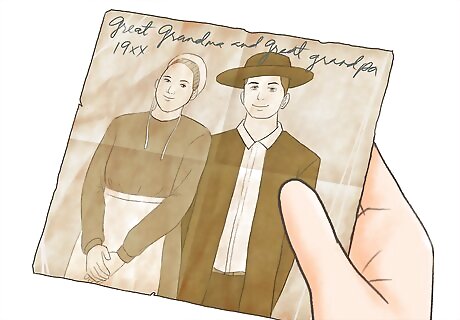
Decide how far back to go. If you have a fairly large family, it might be best to only go back a few generations, such as up to your grandparents and their siblings. If your family is a bit smaller, maybe you want to go back to your great-grandparents or even your great-great-grandparents if you can find any information about them. Think about how much space you have on your family tree and how detailed you want it to be. If you want to add more detail to your family tree, you always have the option to add more paper and extend your drawing. What’s most important is how much research you’re willing to do and how much information about your family is readily available to you. Write down all of the family members you plan on including so that you have a general idea of how much space your tree will take up on your paper.
Planning Your Drawing
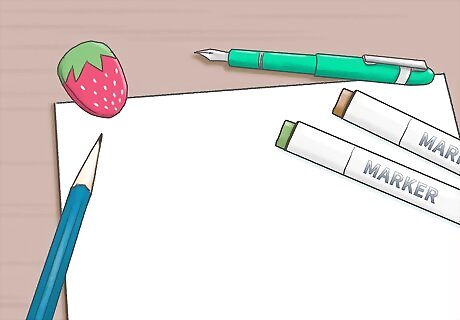
Choose paper and a drawing utensil. Pick out nice drawing materials to present your family history in a super aesthetic and eye-catching way. Choose a large sheet of paper that’s sturdy and can fit all the information, such as watercolor paper or poster board. Use some nice markers, colored pencils, or watercolor pencils to add a pop of color and detail to your tree.
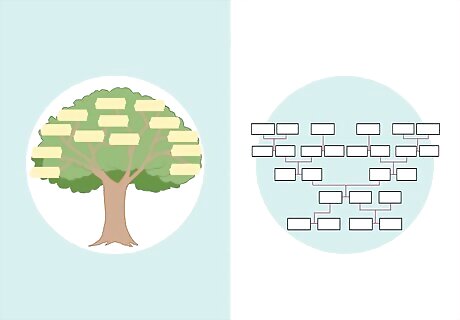
Decide between a more artistic tree or a standard genogram. Some family trees are drawn in the shape of actual trees that have a branch for each member of your family. Drawing a genogram, on the other hand, means you’re mostly drawing shapes and straight lines to represent your family and their relationships. With a genogram, you typically don’t overlay the diagram on an actual sketch of a tree. Choose the style that best suits your vision.
Drawing the Tree

Sketch the tree lightly in pencil. Envision what it will look like and plan how much space you need to write each name and draw the necessary connections. Starting with pencil is a good idea in case you make a mistake and need to erase and go back. Start from the base of the tree and work your way up the trunk and outwards toward the individual branches. Make a branch for each family member. In these kinds of family trees, the parents are often placed in the junction where the branches split, and their children’s names are written on separate branches coming out of that junction. Refer back to the list of family members you made to check how each person is related so that you can draw the correct connections and make sure no one gets accidentally left out.

Write your name on your branch. Since this is your family tree, it all begins with you. Place yourself near the center or bottom of the page. Older generations will go below you and younger family members will go above you, so leave plenty of space for your other relatives.
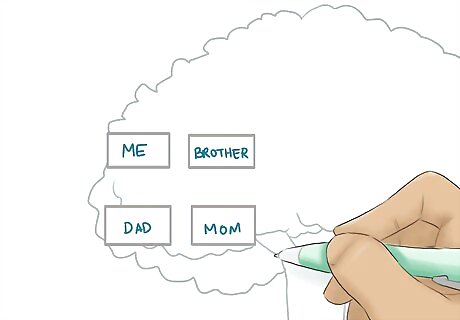
Add your parents and siblings. Write your parents' names directly above your name. Write your siblings' names in line with your own so that they extend from your parents' names. If you and your siblings have spouses or children, write them as well. Spouses' names are written directly next to their partners’, and the children's names are written below their parents' names. Draw lines connecting parents, siblings, and children to make the relationship more obvious. Tailor the tree to fit your family. If you have one parent or more than two parents, fill them in as well. Include step-parents, step-siblings, and anyone else who is part of your family. To keep your tree well-organized, come up with a pattern for listing siblings. For example, write siblings’ names oldest to youngest starting from the left. Whatever you choose, keep it consistent throughout the tree.
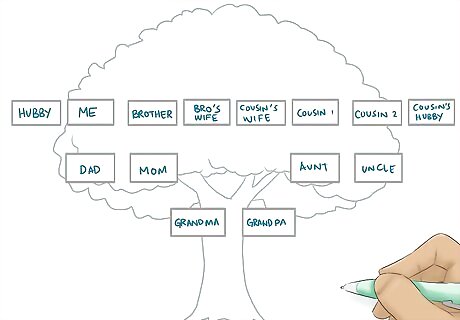
Write in your aunts and uncles, cousins and grandparents. This is where your tree will really start to grow. Branching out from your father’s name, write in his siblings' names, their spouses, and their children (your first cousins). Write your father's parents' names (your paternal grandparents) on the next level with a branch extending from them to each of their children. Do the same on your mother's side of the tree, including all the members of your extended family on that side.
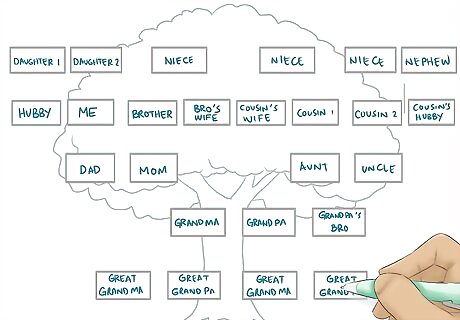
Include more generations. Continue adding the names of your great-aunts and uncles and their spouses and children, your great-grandparents, and so on until you've filled in as much of the family tree as you want. The oldest generation you want to include will be placed at the roots of the tree. This might be your parents, grandparents, great-grandparents, or even further back.
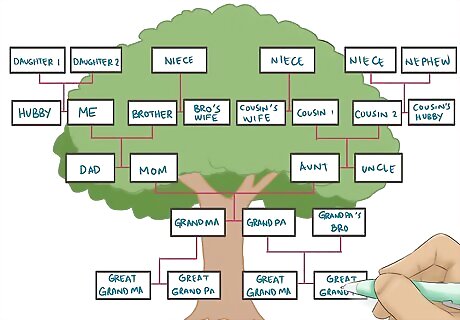
Enhance it with more detail. Retrace the tree in black or colored ink to make the names and outline stand out. Add decorations and other details to make the tree more colorful and aesthetic. For example: Use different shapes for males and females. For example, use ovals for females, rectangles for males, and diamonds if their gender is unknown. Represent divorced couples with a dashed line connecting them. Add dates of birth and (where applicable) death. Add more biographical information for each individual, such as place of birth, maiden name, middle name, and more.




















Comments
0 comment